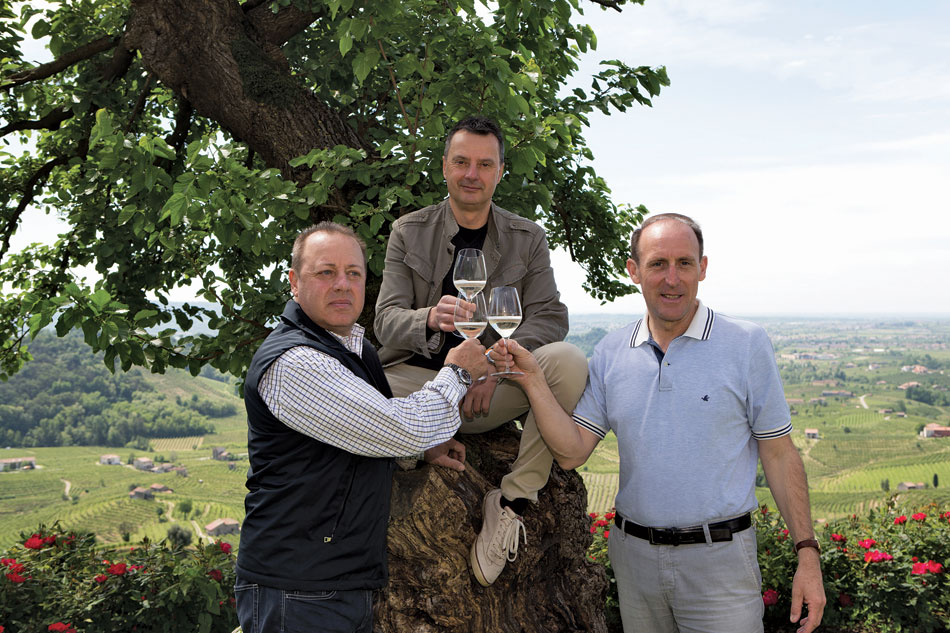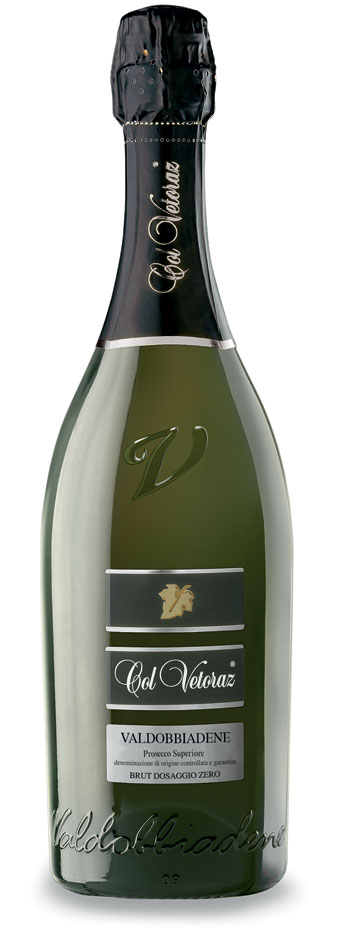02 August 2018
Prosecco is easy. It gets along well with just about any occasion and food, and we love it for that. But that doesn't mean it lacks depth and character.
Prosecco is beginning to take itself seriously. For the past several years, sales for this popular sparkling wine from northern Italy have not stopped climbing. But, this doesn’t necessarily mean that producers are pumping out as much as possible. On the contrary, Prosecco is becoming more nuanced and complex (though no less fun!), if you know where to look.
A fun and easy drink
Prosecco has long been touted as a party drink, the easy-going bubbly that pairs with just about anything. It is, perhaps incorrectly, often compared to Champagne, likely for the simple reason that the two are the world’s most popular sparkling wines. There are crucial differences between the two, however, beyond the fact that one is from France and the other is from Veneto, Italy.
 Glera grapes - © Courtesy of Col Vetoraz Winery
Glera grapes - © Courtesy of Col Vetoraz Winery
Prosecco is slightly sweeter and fruitier, making it popular in the cocktails department and the perfect aperitif. It whets the palate gently, without an overdue amount of acidity. It is the go-to alcohol for brunch, either mixed with a mimosa or Bellini—whose original recipe was made with Prosecco, by the way.
Prosecco and Champagne are made using two different methods, generally, as well as different grapes. Champagne must be made with the champenoise method, while Prosecco is usually (though not strictly) made using the Charmat method, or fermentation in stainless steel tanks. This makes Prosecco less expensive and, as Eric Asimov notes, with a cleaner taste and aroma profile. The grapes that go into Prosecco are best displayed with the cleaner tank fermentation method. Prosecco retains its delicate fruitiness and notes of peach, green apple, honeydew, cream, and pear.
Finally, Prosecco is most traditionally made with the local glera grape, though other varieties may be blended, such as chardonnay, pinot gris, and pinot noir, and local varieties perera, bianchetta, and verdiso. Champagne, on the other hand, is usually made of a blend of chardonnay, pinot noir, and pinot meunier.
Centuries-old history and UNESCO nomination
Today, Prosecco is seen as an easy-going drink. Easy to pair, easy to drink, easy to enjoy. But don’t be fooled: just because you get along well with others doesn’t mean you lack depth. And Prosecco has an astoundingly profound background that few know of. Proof of the fact is in the UNESCO nomination of its most traditional production area, Conegliano-Valdobbiadene, to be named a World Heritage.
Wine production in the Veneto reaches back at least 1000 years. The first written mention of Prosecco was in 1754, but even before that, the town of Conegliano poured white wine from the Fountain of Neptune in 1574 to honor King Henry III of Poland. And in 1876, the School of Winemaking was founded in Conegliano, the first of its kind in Italy.
The traditional winemaking territory of Prosecco is called the Conegliano-Valdobbiadene. It has been producing wine for hundreds of years, and was first cited specifically in context with Prosecco in 1772. It was described as a vine-growing area as far back as the 6th century. The area extends through the hills of the Province of Treviso between the towns of Conegliano and Valdobbiadene, between the Dolomites to the north and the Adriatic, giving the vineyards excellent microclimates for vine cultivation.
 Steep, terraced vineyards of Valdobbiadene - © Courtesy of Col Vetoraz Winery
Steep, terraced vineyards of Valdobbiadene - © Courtesy of Col Vetoraz Winery
The territory was submitted for UNESCO World Heritage in 2010 for the strong bond between an ancient vine-growing culture to the land, but also for its beauty: its terraced vineyards against an Alpine backdrop form one of Italy’s most stunning territories. The steeply sloping hills have necessitated work and harvest done entirely by hand, often called “heroic viticulture” due to the demanding nature of the labor.
Popular Prosecco is focusing on quality over quantity
Prosecco has been in the news lately—for the past several years, in fact. Exports and production have not stopped growing in response to increasing consumer demand. This has led to concern over poor-quality Prosecco; the Prosecco-producing area casts a wide net, and not all of it is top quality. But that is not the case everywhere, and certainly not in the area of Conegliano-Valdobbiadene. Here, producers have begun to focus on quality over quantity, creating nuanced wines for a more discerning public. But don’t worry; they are still light and accessible.
 Owners of Col Vetoraz - © Courtesy of Col Vetoraz Winery
Owners of Col Vetoraz - © Courtesy of Col Vetoraz Winery
An excellent example of this is Col Vetoraz. Located in Santo Stefano di Valdobbiadene, all seven of their sparkling wines are Valdobbiadene DOCG, the top-quality designation for a wine, or Denomination of Controlled and Guaranteed Origins. The winery strives to preserve the natural characteristics found in their grapes during production, “using the best and latest technology so as not to subtract or add anything that nature has already given the grapes.” As the winery’s enologist, Lori Dall’Acqua, states, “The only way to obtain the natural balance and harmony that the vines have given us is by scrupulously following a production method that preserves the expressive integrity of the grapes.”
Several of Col Vetoraz’s labels are further distinguished for rare traits not found in your run-of-the-mill Prosecco; top-shelf sparkling wines, in other words.
 For example, there is the Brut Dosaggio Zero, or without extra sugars added for fermentation, leaving a sugar residue of zero. It is the driest category of Prosecco, yet it remains creamy and round in the mouth with signature fruity and floral flavors. Their Millesimato Dry is unusual in that, unlike many sparkling wines (even those from Champagne), it is made from a single vintage as opposed to a blend of a couple of years—this is what “millesimato” means. With its scents of rose, citrus fruit, acacia, white peach, pear, and apple, it is an elegant and aromatic choice for a celebration or pairing with just about any food.
But perhaps the most unique and special label is a famous Cartizze Superiore cru wine. A cru wine is a single-vineyard wine, bottled without blending grapes from other vineyards because the terroir of the vineyard is discernible and unique in the glass. The Cartizze cru makes some of Italy’s most prestigious (and expensive) sparkling wines. Col Vetoraz is situated at the highest point of the celebrated Cartizze hill at almost four hundred meters above sea level. Intense and delicate at the same time, the Col Vetoraz Cartizze Superiore DOCG has a creamy foam and aromas of flowers and ripe fruits. This is certainly a wine for toasting the most special celebrations.
For example, there is the Brut Dosaggio Zero, or without extra sugars added for fermentation, leaving a sugar residue of zero. It is the driest category of Prosecco, yet it remains creamy and round in the mouth with signature fruity and floral flavors. Their Millesimato Dry is unusual in that, unlike many sparkling wines (even those from Champagne), it is made from a single vintage as opposed to a blend of a couple of years—this is what “millesimato” means. With its scents of rose, citrus fruit, acacia, white peach, pear, and apple, it is an elegant and aromatic choice for a celebration or pairing with just about any food.
But perhaps the most unique and special label is a famous Cartizze Superiore cru wine. A cru wine is a single-vineyard wine, bottled without blending grapes from other vineyards because the terroir of the vineyard is discernible and unique in the glass. The Cartizze cru makes some of Italy’s most prestigious (and expensive) sparkling wines. Col Vetoraz is situated at the highest point of the celebrated Cartizze hill at almost four hundred meters above sea level. Intense and delicate at the same time, the Col Vetoraz Cartizze Superiore DOCG has a creamy foam and aromas of flowers and ripe fruits. This is certainly a wine for toasting the most special celebrations.
